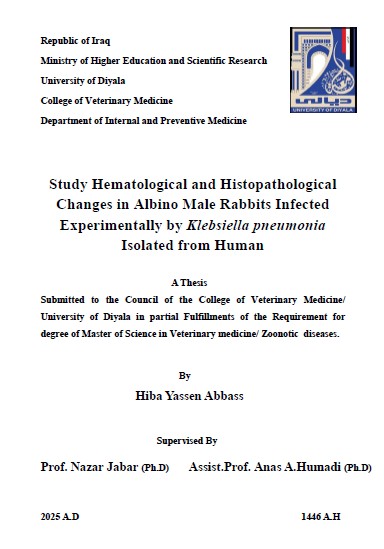Abstract
The study was conducted on 65 urine samples, collected from patients suffering from urinary tract infection, 125 blood samples collected from pediatric patients suffering from unexplained fever and 100 stool samples collected from patients suffering from persistent diarrhea, from both Genders with different ages, during the period (September–December 2023), at AL- Batool Hospital, and Ba’quba Teaching Hospital- Iraq, Diyala of Ba’qubah City. The samples of urine, stool and blood were submitted to bacterial examinations in order to isolate and identify Klebsiella pneumoniae. The samples were cultured on selective media (MacConkey and EMB agar) for morphological examination then identified by biochemical test and confirmed by Vitek-2 test. Results of total bacterial isolates which diagnosed as Klebsiella pneumoniae sp. pneumoniae was only six isolates out of 290 (2.30%). Two positive results out of (65) urine samples (3.07%), three positive results out of (100) stool samples (3%), and only one positive result from 125 blood samples (0.8%).
An experimental study was conducted in 30 albino male rabbits, After the two-weeks of adaption period, in the Animal House of College of Veterinary Medicine. A total of 30 male rabbits were divided into three groups: First group (GI): was given (1CC /animal) an oral dose of phosphate buffer saline (PBS) by a stomach tube as a control group for 60 days, second group (GII), were given one dose weekly (1CC) of viable K. pneumoniae (1 X 106 CFU/ml) orally by stomach tube for 60 days, third group (GIII): were given twice dose weekly were given (1CC) viable K. pneumonia (1 X 106 CFU/ml) orally by stomach tube for 60 days.
During the (14 days) Albino male rabbits exposure to viable K. pneumoniae sp. pneumoniae, the main clinical signs were observed in the second and third group, including fever, dyspnea, diarrhea, cramps, and difficult urination have also been seen. After (60) days of experiment, under general anaesthesia the whole blood samples were collected from the heart and then put in EDTA tube to use of hematological analysis and DNA comet assay.
Then Hematological analysis done at the Veterinary Hospital of Baghdad and DNA comet assay done on AL-Nahrin University and measure the damage of DNA in head and tail in lymphocytes.The animals were euthanized and collection of tissue samples about one centimeter in length were obtained from internal organ (Intestine, Liver, spleen, lung and kidney) for observe grossly and histopathologically. Klebsiella pneumoniae caused severe pathological changes in different organs, particularly lung tissue, kidneys, and gastro intestinal tract (GIT).
The result of blood test showed that there was a significant decrease of RBCs, Hb and PCV, while significant increase in WBCs, lymphocytes, monocytes and neutrophil in third and secondgroup in compare to control group.DNA comet assay: The lymphocytes were isolated by blood centrifugation and collected the buffy coat then diluted with 5ml Phosphate Buffer Saline (PBS) and centrifuged, after a number of steps which done until lymphocytes cells precipitated and collected, then DNA comet process done and examine slide under fluorescent microscope, Pictures of DNA damage quantification by use image analysis software comet score program. which show severe damage in lymphocytes and the parameter modification tail length, tail intensity, tail moment and percentage of DNA in tail measured, a comparison between the three groups was done, observing severe damage in lymphocytes in the third group and slightly damage in the second group in comparison to no damage in control group.
Finally, the pathological changes of three groups for samples were obtained from the intestine, liver spleen, lung and kidney, after histology prcedure and staining by hematoxylin and eosin stain then microscopic examination, the gross appearance of first group (control) showed no significant of any pathological changes in all organs (Intestine, liver, spleen, lung and kidney), while in second and third group, intestine histopathological changes included: edema in sub muscular layer with hemorrhage and infiltration of mononuclear cells in mucosa and sub-mucosa, increased in crypt goblet cells with mucin and congestion of blood vessels, elongated villi, and muscle vacuoles.
Liver histopathological changes represented by causing liver abscesses, hemorrhage also showed edema and congested vein, necrotic hepatocytes with vacuoles, and finally acute cellular swelling, and mononuclear cells surrounded the bile duct, severe mononuclear cells pre portal area with increase in kupffer cells, also showed width sinusoid with fibrin, also showed liver cirrhosis, hemorrhage, with mononuclear cells infiltration.
Spleen histopathological changes included thickening of capsule with severe hemosiderosis, hemorrhage with severe spleenitis, congested central atrophy, depleted pulp with hemorrhage, depleted follicle, severe edema, also showed macrophage laden hemosiderin, free hemosiderin.
Lung histopathological changes included: interstitial pneumonia with hemorrhage with ballooning emphysema, and dilated blood vessels, mononuclear cells infiltration with thickening artery, also showed increase in epithelial columnar cells of bronchus, hyperemia of artery, in other section showed edema, congested of blood vessels with slight thickening in the alveolar cells, thickening in interlobular septa, also thrombus in pulmonary artery also showed fibrosis of bronchus, hyperplasia of epithelium with arteriosclerosis, alveoli atelectasis. Histopathological changes of Kidney included cortex with acute cellular swelling, edema with interstitial nephritis, dilated of blood vessels, infiltration of inflammatory cells (mononuclear cells), congested of blood vessels for glomeruli tuft, interstitial hemorrhage, narrowing of bowman space with acute cellular swelling and atrophied glomeruli





